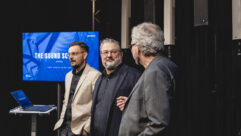The electronic acousticianUsing electronic architecture creates warmth,atmosphere and a more satisfying orchestral experience.
Jan 20, 1997 12:00 PM,
By Jonathan LaneyLaney is with Jaffe Holden Scarbrough Acoustics in Norwalk, CT.
Electronics and digital processing are accepted virtually everywhere: in the car, at the movie theater, at Broadway productions and at the local jazz club. But where does the concert hall fit in? The cherished space must be “au natural” – the bow across the string, the vibrations through the air reflecting off the walls, ceiling and floor untouched by the world of electronics. The concert hall itself is an instrument and contributes to the performance; it is an active participant in the production of sound. When traveling, an orchestra must approach a piece of work differently depending on the unique acoustical nature of the particular halls. On occasion an orchestra can sound great in its own hall but mediocre in a strange hall.The manipulation of sound is the acoustician’s job. For years, sound has been manipulated with bricks, wood and fabric, not to mention movable surfaces, canopies and reflectors. So who is to say what’s natural?
What are good acoustics?When asked that question, I reply, “For what?” Good acoustics for one type of program is not always good for another. Today acousticians consciously study and manipulate the relationship of direct sound to the early and late reflected energy to design a space appropriate for the intended programming. This same relationship was subjectively understood by the composers and musicians and subconsciously incorporated into their works.
As Leo Beranek writes in Music, Acoustics & Architecture: “It is apparent that many early composers were constrained in their choice of musical material by the acoustics available to them for performance. It is certainly not a coincidence that Gregorian chant sounds best in acoustics similar to those of the medieval cathedrals in which it was originally performed – where the reverberation time may be as long as 5 to 10 seconds…. The composer Giovanni Gabrieli, who was organist of St. Mark’s Basilica…wrote chordal music in slow tempo for antiphonal choirs and assemblies of brass or wind instruments, music particularly well-suited to the acoustics of a large reverberant church.”
As we can see, acoustics seem to have driven the creation of music appropriate to the available performance spaces, and as these spaces changed, so did the compositional techniques. Today if one hall is to be used for performances of works from different stylistic periods, by what acoustic criteria should the acoustician design? The same acoustic space best suited for music from the Romantic period would make the typical music from the classical period sound muddy and undefined. So who has the right to say what acoustics are good or appropriate?
Acoustics is the science of sound, but it is also the fusion of music and science. Within this lies the art, the ability to translate the subjective into quantitative factors by which a room can be created to satisfy both the performer and audience. Over the years researchers have worked to correlate the subjective to the quantitative, and studies by Beranek, Theodore Schulz and Chris Jaffe have led to a translation system that provides insight into the music community’s meaning of warmth, intimacy and transparency. The Architectural Acoustic Translation System, as refined by Jaffe, provides a third-eye view of the yin-yang of acoustics. (See Table 1.)
This translation system and others like it are based upon the early work of Beranek, who has created the basis by which today’s halls are designed. From this translation system and the many studies done with performers and listeners alike, the following items were deemed the critical features of good architectural acoustic design.*Early field: Initial time delay gap (ITDG) is the time it takes the first reflection to reach the listener after the arrival of the direct sound. This time is critical to the perception of acoustical intimacy, presence, articulation and brilliance in music. Studies have shown that concert halls with an ITDG between 8 ms and 25 ms receive the greatest approval from listeners and are said to provide good intimacy, presence, articulation and brilliance.*Warmth field: Musical warmth is the presence of the bass instruments in a hall. Schulz’ studies found the link between the listener’s perception of warmth and the strength of the low-frequency reverberant field and its relation to the direct sound emanating from the stage. Bass presence is governed by the energy below 250 Hz in the time period approximately 75 ms to 300 ms after the direct sound.*Reverberant field: Reverberation, also called running liveness or wetness, is the element of acoustics weaving the individual sounds into a cohesive listening experience, which is described by listeners as a sound immersion. The classic definition of reverberation is the time it takes a sound to decay by 60 dB once the source is shut off. Studies have shown that concert halls with a reverberation time within the range of 1.8 ms to 2.2 ms receive the greatest approval for symphonic music.
The application of this translation has proved successful, and in a one-purpose concert hall, it is clear how one must apply these rules to achieve successful results. However, when designing a multi-use hall that must meet acceptable acoustic criteria for a varied program of symphony, opera, musical theater and amplified popular entertainment, the task becomes more involved, requiring a method that can rapidly vary the acoustic environment from event to event at minimum cost and with little architectural impact.
Two methods respond to this need. One is varying the acoustical environment with physical changes, for example, movable ceilings and variable absorptive surfaces; the other method is simulating the effect of the physical changes through electronic means or electronic architecture.
What is electronic architecture?Electronic architecture is the modification of the acoustic fields in performance spaces through the use of audio technology. It is not a PA system with a close-miked orchestra and a reverb unit patched into the main outputs of a mixing console. It is a means of simulating sound reflection patterns with the use of critically placed microphones and loudspeakers supported by carefully tuned electronics and digital processing.
Electronic architecture does not take control of the orchestra’s sound away from the conductor and place it at the hands of a sound technician behind a mixing console. Neither does it amplify or make louder the sound of the orchestra. Electronic architecture makes use of all the advantages of good physical acoustic design and creates what the geometry and volume of the room cannot.
The same critical features contributing to the success of architectural acoustics using physical means are also the basis of design for electronic architecture. The specific criteria for an electronic architectural system that is used for symphonic presentations must meet these four goals:*Provide early energy within the acceptable ITDG of 8 ms to 25 ms.*Extend the RT60 into the range of 1.8 to 2.2 seconds.*Allow the reverberation to be frequency dependent.*Provide the listener with a diffuse sound field.The success of any electronic architecture system depends upon:*The proper understanding of the room’s physical acoustics.*The use of a concert shell or enclosure (the walls and ceiling surrounding the orchestra improving orchestral balance, on-stage hearing and direct projection into the hall).*The choice of microphones and their placement.*The placement and coverage of the loudspeakers.*The proper setting and tuning of both the shell and the system.
Just as no single turnkey sound-reinforcement system suits the needs of every venue, each electronic architecture system for an existing or new room must be analyzed and treated as a unique case. Each potential hall’s geometry, surface types, volume and stage-to-audience relationships influence the placement of the microphones and loudspeakers.
A brief historyThe use of electronic architecture is not something new; as early as the 1930s acousticians were experimenting with electronic augmentation of acoustical environments. RCA conducted the earliest of these experiments at the Philadelphia Academy of Music, trying to energize the reverberant stairwells adjacent to the hall to increase the perception of reverberation within the hall. The current state of the art has evolved from a long and distinguished history of experimentation, testing, application and use. Important contributions have been made by many notable names in the acoustical and musical fields. These pioneers include Paul Veneklasen and his reverberant chamber approach, the Aeolian Skinner Organ Company and its tape delay system, Peter Parkin and the Assisted Resonance (AR) system, Jaffe with the Electronic Reflected Energy System (ERES), Mahlon Burkhard and the multitap signal delay developed at Industrial Research Products, Peter Barnett with his Reverberation-on-Demand System (RODS) and David Griesinger and LARES developed at Lexicon.
ReactionsAs the capabilities of audio technology advanced, the feasibility and success of these systems has been realized. Success in the classical music community can be seen in both the early development of this approach and in today’s refined systems based on the latest technology. From early on, critics, audiences and performers alike have praised the results of electronic architecture.
*Laurie Auditorium of the San Antonio Symphony: “The Laurie Auditorium, long known for its terrible symphonic acoustics, has had a ‘sound lift,’ and the difference is monumental.” – Don Huff, San Antonio Herald, Oct. 13, 1977.*Hult Center of the Eugene Symphony: “I’ve sung in every great theater in the world and here in Eugene you have the very top of the earth.” – Marilyn Horne, Musical America, Feb. 21, 1983.*Circle Theatre of the Indianapolis Symphony: “The acoustics were clear, well defined with a good deal of presence, solid bass and excellent definition.” – Harold Schonberg, New York Times, Nov. 5, 1984.
Circle Theatre, an exampleTo see what electronic architecture can do, let’s look at a specific venue that benefited. The Circle Theatre is the permanent home of the Indianapolis Symphony Orchestra. The volume in the audience seating area is only 315,000 ft2 (29,264 m2), providing a volume-to-seat ratio of only 165. The minimum ratio necessary in this size hall for symphonic programs is considered to be 300. A limited budget and the fact that the building is on the Historic Register eliminated the possibility of raising the roof to gain volume. Even though the stage house is used as a coupled space, it alone was not enough to meet the symphonic acoustic criteria for reverberation. So it was either abandon the project or implement electronic architecture. In 1984 the Circle Theatre became an early example of how a former movie palace could be renovated to accommodate the acoustic needs of a symphony orchestra with the help of electronic architecture.
That was 12 years ago, and with the advancement of technology and the aging of the original equipment, it was time for an update. Using the latest digital processing, improved loudspeaker components and the latest design philosophy, the hall was rejuvenated. Many of the existing loudspeaker locations and much of the wire were reused, but all new equipment was installed – everything from the microphones to the loudspeakers.
Placement and type of loudspeaker are based entirely on the architecture of the building and how the loudspeakers can be hidden from view. At the Circle Theatre, loudspeakers are placed and chosen for three distinct acoustical spaces: the main floor, the under balcony and the over balcony.
The subwoofers for the main floor are tucked into the moat and plenum areas, allowing the low frequencies to rise up through the air return mushrooms, enveloping the main floor with “warmth.” The over balcony has subwoofers suspended above the ceiling in the attic, placed behind decorative grilles, supplementing this area with the required warmth. Under the balcony the “warm energy” is supplemented by 12 inch (305 mm) sub loudspeakers mounted in large back cans.
The primary early and reverberant field loudspeakers for the main floor are mounted in former organ lofts behind the decorative grilles. High-quality ceiling-type loudspeakers supplement the early and reverberant fields to the under and over balcony areas.
The support electronics focus on the three distinct acoustic spaces and allow individual adjustment of each space in both frequency response, delay propagation and reverberant and early energy algorithm. The heart of the reverberation and early reflection is the LARES unit. This unit provides the primary spatial enhancement algorithms and provides control over the level, length and frequency characteristics of the reverberation enhancement.
A touchscreen panel gives the user control over a variety of functions, including system power on and off, microphone positioning, selection of preset programs or acoustical environments and system self-testing. In the past, users have only wanted system on-and-off control, but now the ability to select various acoustical environments has drawn more interest and is becoming more widely accepted.
How successful was the investment in updating the Circle Theatre’s electronic architecture system? Tom Aldridge in the Oct. 17-24, 1996 issue of NUVO Newsweekly wrote, “…tremendously so, I think. Though producing a bright sound with excellent ensemble clarity, the Circle Theatre has also tended to sound dry and constricted in bass. Both problems have now been corrected to the extent that people are, I believe, reacting subliminally to the impact it has made on them. Everything sounds bigger, better.”
Is it natural?This question is raised any time loudspeakers, amplifiers and electronics are mentioned in association with a concert hall. Electronic architecture is an emotional issue; sometimes musicians, conductors and patrons alike prefer to rely on the physical acoustics even if they are less than perfect. Some think that somehow their experience is being manipulated, cheating them from the true re-creation of the composer’s work.
Even in the world’s greatest concert halls, the sound is manipulated. As sound travels around a space, it changes each time it reflects off a wall, ceiling or floor surface; it is even changed by traveling through the air. How much it changes depends on the nature of the materials. The manipulation by these materials is what gives a hall its acoustical character. And just like the greatest concert halls, an electronic architecture system does not affect the direct sound; it creates the reflections and reverberation necessary for a good listening experience. As Jaffe has asked, “When valves were added to horns, did that detract from the musician’s skills or provide artistic opportunities?” And don’t forget what Beranek wrote: “The early composers were constrained in their choice of musical material by the acoustics available to them for performance.”
So what, then, is considered natural – hearing and performing the work in the space it was written for or perhaps its exact physical replica? What does this say about the state of the art when few tread any further then to copy a successful hall built a hundred years ago? Where is the creativity, the adventure or the vision of what acoustics, music and performance can be?
Just the beginning…Electronic architecture provides a tool to deliver the natural acoustic, not just for the classical period but for the Romantic, Renaissance and Baroque. The combination of solid knowledge of physical acoustics and the implementation of electronic architecture can provide not only the varied environments for the pieces of antiquity but can literally be the spring board for the composers of today and tomorrow. Much like IRCAM in France, a hall that allows total flexibility in the physical adjustment of the room, specific pieces could be scored for the electronic system, providing another instrument to the composer.
Will the scores of tomorrow not only have notations for forte and pianissimo but also notations for RT60 and bandwidth? Will the conductor not only have a baton and score but a control panel? Will a tone meister be seated next to the concert master? A pipe dream perhaps, but how would Frank Zappa have viewed this opportunity to expand the orchestration of his later works, or how could Philip Glass, Steven Reich or Gavin Bryers use this to expand their visions and artistry?
I think it is time we move beyond the presumption that acoustics are only natural when air, wood, brick, plaster and fabric are the sole manipulators of sound. With knowledgeable and sensitive use, electronics and DSP may provide not only the solution to the greater artistic diversity demanded by today’s multipurpose halls but, like the valves on a horn, provide an opportunity for greater artistic creation.
Selected bibliographyLeo Beranek, Music, Acoustics & Architecture, John Wiley and Sons, 1962.Leo Beranek, How They Sound, Concert and Opera Halls, Acoustical Society of America, 1996.Virginia K. Dorris, “Wired for Sound,” Architecture, August 1992.J. Christopher Jaffe, “Application of Advanced Electronic Systems to Concert Halls and Auditoriums,” Acoustics Australia, Vol. 16, No.1.J. Christopher Jaffe and Paul H. Scarbrough, “Electronic Architecture: Toward a Better Understanding of Theory and Application,” Proceedings of the AES 93rd Conference, Audio Engineering Society, 1992.J. Christopher Jaffe, “Stop, Look, and Listen,” Symphony News, Vol. 25, No. 2, May 1974.Christopher Jaffe, “Electronic Architecture,” Jaffe Holden Scarbrough Acoustics.Paul H. Scarbrough, “ERES Owner’s Manual,” Jaffe Holden Scarbrough Acoustics.










